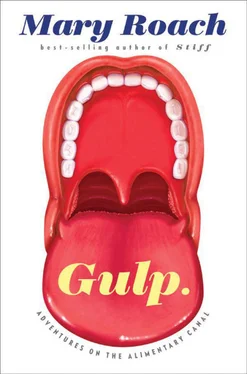The Salivette makes an unmistakable point: your parotid glands don’t care what you chew. There is nothing remotely foodlike about superabsorbent cotton, yet the parotids gamely set to work. They are your faithful servants. Whatever you decide to eat, boss, I will help you get it down.
Allowing you to eat is the most obvious but far from the only favor granted by saliva. Silletti removes a bottle of wine vinegar from a tote bag. With a dropper, she squirts some on my tongue. “Do you feel it? Saliva is coming in the mouth to dilute the acid.” It’s as though I’d taken a sip of tepid water. “The communication between the brain and mouth,” says Silletti with infectious wonder. “It’s so fast!”
Vinegar, cola, citrus juice, wine, all are in the acid range of the pH scale: from around pH 2 to 3. Anything under pH 4 will dissolve calcium phosphate, a key component of tooth enamel. The process is called demineralization. Take a drink of anything acid, and if you are paying attention, you will notice a sudden warm slosh: parotid saliva arriving like the cavalry to bring the pH back up to the safe zone. Earlier, Silletti paged through a Dutch-language textbook on saliva ( speeksel ) to show me close-up photographs of teeth belonging to dry-mouthed people—those with Sjögren’s syndrome or whose salivary glands have been damaged by radiation treatments. “It’s really shocking,” she said, and it was: gaping brown lesions all along the gum line. “Their teeth are so soft that they cannot even eat properly.”
Sugar contributes to tooth decay only indirectly. Like humans, bacteria are fond of it. “Bacteria get all crazy—party, party—they metabolize the sugar, break it down, and they release their metabolites, and these are acid” (though not as acid as cola or wine). In other words, sugar itself doesn’t cause cavities; it’s the acidic metabolites of the bacteria that feed on the sugar. As with acidic foods, saliva dilutes the acid and brings the mouth back to a neutral pH.
You may be wondering, though probably not, why newborns—who have no teeth to protect—produce excessive volumes of drool. Silletti has answers. One is simple mechanics. “They lack teeth to physically keep it in there.” Your lower incisors are a seawall holding back the salivary tide. The other reason is the newborn’s high-fat, 100 percent whole-milk diet. Baby saliva—so cute!—contains extra lipase, an enzyme that breaks down fats. (Adults have lipase mainly in their intestines.) More saliva means more lipase. As babies move on to a more varied diet, the salivary lipase tapers off.
The main digestive enzyme in stimulated saliva—everyone’s, regardless of age—is amylase. In Silletti’s dancing Italian accent it sounds like a liqueur or a European ingénue. Amylase breaks starches down into simple sugars that the body can use. You can taste this happening when you chew bread. A sweet taste materializes as your saliva mixes with the starch. Add a drop of saliva to a spoonful of custard, and within seconds it pours like water.
This suggests that saliva—or better yet, infant drool—could be used to pretreat food stains. Laundry detergents boast about the enzymes they contain. Are these literally digestive enzymes? I sent an e-mail to the American Cleaning Institute, which sounds like a cutting-edge research facility but is really just a trade group formerly and less spiffily known as the Soap and Detergent Association.
With no detectable appreciation for the irony of what he had written, press person Brian Sansoni referred me to a chemist named Luis Spitz. And when Dr. Spitz replied, “Sorry, I only know soap-related subjects,” Sansoni—still without a trace of glee—gave me the phone number of a detergent industry consultant named Keith Grime.
When I’d composed myself sufficiently, I put in a call to Grime. The answer is yes. Higher-end detergents contain at least three digestive enzymes: amylase to break down starchy stains, protease for proteins, and lipase for greasy stains (not just edible fats but body oils like sebum). Laundry detergent is essentially a digestive tract in a box. Ditto dishwashing detergent: protease and lipase eat the food your dinner guests didn’t.
Credit for the idea of using digestive enzymes for cleaning goes to chemist and Plexiglas inventor Otto Röhm. In 1913, Röhm extracted enzymes from livestock pancreases and used them to presoak dirty fabric, perhaps the clothes of the slaughterhouse staff in exchange for the pancreases; history has forgotten the details. Extracting enzymes from animal digestive tracts is costly and labor-intensive. For the first commercially produced laundry enzyme, scientists turned to a protease created by bacteria. Commercial lipase followed soon after. Here the gene was transferred to a fungus. Fungi are bigger and thus easier to deal with. You don’t need a microscope to see your herd, or crop, or whatever collective noun applies to fungi.
Grime told me about an enzyme found on the forest floor that breaks down the cellulose in dead, fallen trees. When he worked at Procter & Gamble, he tried it out as a fabric softener. (That’s how softeners work. They ever so mildly digest the fibers.) That didn’t work out, but the enzyme did something even better. It digested the cotton fibrils that tangle up and form pills on your sweater. (Crushingly, the anti-pilling enzyme doesn’t work on wool.)
We had traveled a long distance from saliva, and I had not asked the question I’d called to ask. It was time to come in from the forest.
“If you dribble something on your shirt while you’re eating,” I asked Grime, “does it make sense to dab it with saliva? As a kind of natural laundry presoak?”
“That’s an interesting thought.”
Dr. Grime carries a Tide stain pen. He does not use his own spit.
Art conservators do. “We make cotton swabs on bamboo sticks and moisten the swab in our mouths,” says Andrea Chevalier, senior paintings conservator with the Intermuseum Conservation Association. Saliva is especially helpful for fragile surfaces that solvents or water would dissolve. In 1990, a team of Portuguese conservators pitted saliva against four commonly used nonanatomical cleaning solutions. Based on its ability to clean but not damage water-gilded gold leaf and low-fired painted clay surfaces, saliva “was judged the ‘best’ cleaner.” Denatured saliva, stripped of its enzymatic powers, was also tested and proved inferior to straight spit.
For more typical cleaning jobs, painting conservators, like laundry formulators, turn to commercially produced digestive enzymes. Protease, the protein digester, is used to dissolve washes made from egg white or hide glues. (Less enlightened conservators of yore used to spread glue made from rabbit hides onto canvases to consolidate flaking paint.) Lipase, the fat digester, is used to eat through the layers of linseed oil that eighteenth- and nineteenth-century painters applied to improve light refraction and “feed the surface” of their artworks.
Chevalier volunteered that some conservators’ saliva cleans noticeably better than others’, and that this occasionally prompted speculation about how many martinis these individuals were having at lunch. In reality, there are naturally large individual differences in the chemical makeup of people’s saliva.
And in people’s flow rates. Silletti and I, for instance, chewed our cotton wads for the same amount of time. I produced .78 milliliters of stimulated saliva; she produced 1.4. She tried to reassure me. “It doesn’t say anything about how good you are or how good I am with saliva.”
“Erika, I’m a dried-up husk.”
“Don’t say that, Mary.”
Silletti excuses herself. “I want to go get some ice. The reason is that even after one minute, this will start to smell very bad.” [39] I can vouch for this. I once toured the refrigerator at Hill Top Research, where odor judges test the efficacy of deodorizing products like mouthwash and cat litter. The president at the time, Jack Wild, was looking for the malodor component of armpit smell, which I had asked to sample. He kept opening little jars, going, “Nope, that’s dirty feet, no, that’s fishy amines” (vaginal odor). I asked him which is the worst. “Incubated saliva,” he said without hesitating. “Both Thelma and I got dry heaves.” I don’t recall Thelma’s title. Whatever she did, she deserved a raise.
Читать дальше












